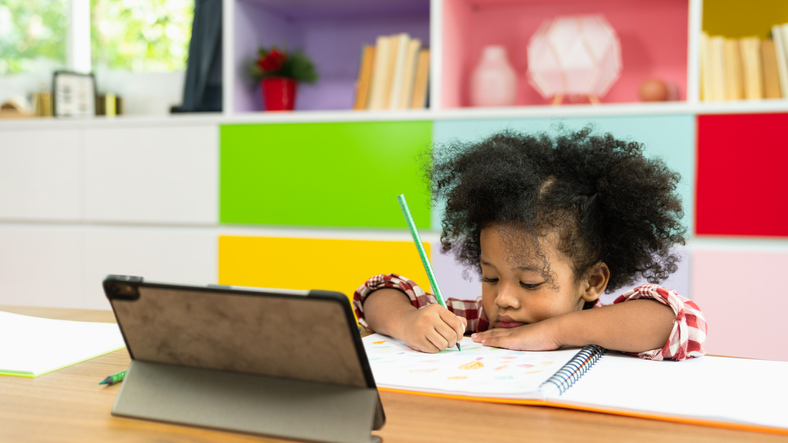 For many students, families and educators this fall, school as we’ve known has changed. Hybrid or remote learning means spending up to seven hours daily online for classes and then more time for homework. Many kids like to relax and connect with their friends via gaming, social media apps or FaceTime. Can overusing technology be a problem for the mental health of kids with ADHD? Can it lead to emotional and/or behavioral difficulties? How can you help your family better manage ADHD and screens at home?
For many students, families and educators this fall, school as we’ve known has changed. Hybrid or remote learning means spending up to seven hours daily online for classes and then more time for homework. Many kids like to relax and connect with their friends via gaming, social media apps or FaceTime. Can overusing technology be a problem for the mental health of kids with ADHD? Can it lead to emotional and/or behavioral difficulties? How can you help your family better manage ADHD and screens at home?
Concerns about ADHD and screen overload
Mood and social connections
When kids with or without ADHD spend too much time on screens, they often become more irritable, lose skills for entertaining themselves and develop fewer critical relationship skills (such as reading facial cues and body language, even with masks on).
Movement and exercise
Risks for obesity increase as the lack of physical exercise and fitness goes down. Exercise, on the other hand, would produce important endorphins and hormones that improve emotional as well as physical well-being.
Anxiety and FOMO
Many of kids and teens with ADHD are already prone to anxiety or dealing with anxiety disorders: 34% of kids with ADHD have a diagnosis of an anxiety disorder. They can become more anxious–worried about FOMO (fear of missing out)–about what they are missing online or how to engage with peers virtually. Many feel pressured to upgrade to new and better equipment. In addition, isolation from less in-person peer contact intensifies the possibilities of depression and social anxiety. The combination of ADHD and screen overload makes it hard to learn and practice skills such as reading facial cues or body signals, having casual conversations or nurturing friendships. 
Manage ADHD and screen time with regular digital breaks
A daily, if not weekly, digital break is an effective tool for improving mental health and giving technologically overtaxed eyes and brains time to recoup. By taking a break from being online, children and teens with ADHD can focus on other areas of their lives. They can nurture interests, activities and interpersonal relationships. They’ll connect to and develop other parts of themselves that improve self-esteem and foster positive moods. Whether it’s cooking, shooting hoops, listening to music or walking the dog, their brains and their eyes need time to recover from processing visual information.
Aim for consistency
Set aside some time each day or maybe once per week without technology. Meals are a good place to start. Then, if you can, expand this to a few hours or even one day a week.
 Include the whole family
Include the whole family
Creating a digital break doesn’t have to incite meltdowns and explosive family arguments. If you make it something everybody does, then it’s more likely to go over better. What kids, especially those with ADHD, can’t stand is when parents tell them to get off their devices while their parents stay on their own phones or iPads. Of course, you may need to make a plan with extended family or work for handling emergencies. Clarify this exception right from the start.
Make it fun for everyone!
 Instead of “doing nothing” during this time, or only dreaded chores, plan a fun family activity that may include raking leaves followed by ice cream. Or, ride a bike or take a walk to a favorite taqueria. Even thirty minutes daily can offer much-needed relief and give you a chance to interact as a family. If you’re lost about ways to start a conversation, try asking about “a happy and a crappy” of the day or week. One of my clients shared this with me and I laughed aloud. It sounded more fun than my simple “a high and a low.”
Instead of “doing nothing” during this time, or only dreaded chores, plan a fun family activity that may include raking leaves followed by ice cream. Or, ride a bike or take a walk to a favorite taqueria. Even thirty minutes daily can offer much-needed relief and give you a chance to interact as a family. If you’re lost about ways to start a conversation, try asking about “a happy and a crappy” of the day or week. One of my clients shared this with me and I laughed aloud. It sounded more fun than my simple “a high and a low.”
Maintaining ADHD and screen sanity in the long run
By taking these breaks from various types of digital life, you can give your family and yourself some space to do something else without FOMO. Everything–social media, gaming, surfing the net–will still be there when you return. While managing ADHD and screen time with a digital break will be challenging at first, the long-term pay-offs are worth it. Stick with it, and negotiate the terms of how and what screen-free time looks like. Expect pushback, and do it anyway. You’ve got this!
Learn more:
https://drsharonsaline.com/product/managing-technology-families-video/ https://drsharonsaline.com/product/online-learning-tips-for-parents-bundle/
 People who are very engaged in social media must use caution to ensure that they don’t place more value on their virtual friends, or how many or few they have, versus their in-person relationships. We can all get distracted by the online world, believing that things are happening without us (FOMO: Fear of Missing Out) or feeling pressure to respond to posts immediately. This focus means that we may well struggle with interpersonal conversations, especially about difficult subjects, in real time, face-to-face with true friends. I recommend to all my clients, especially those with ADHD who can struggle socially, that sending messages or ‘talking’ online, where you don’t often see another person’s reaction, can possibly make you misinterpret their intentions. In relationship, we have to learn through interpersonal communication and time spent together in the same space to read each other’s emotional weather report and respond appropriately. When people spend more time engaged with each other rather than their screens, they perceive and understand social nuances and learn how to deal with positive and negative feelings with empathy and consideration. This enriches relationships and deepens connections. Read more:
People who are very engaged in social media must use caution to ensure that they don’t place more value on their virtual friends, or how many or few they have, versus their in-person relationships. We can all get distracted by the online world, believing that things are happening without us (FOMO: Fear of Missing Out) or feeling pressure to respond to posts immediately. This focus means that we may well struggle with interpersonal conversations, especially about difficult subjects, in real time, face-to-face with true friends. I recommend to all my clients, especially those with ADHD who can struggle socially, that sending messages or ‘talking’ online, where you don’t often see another person’s reaction, can possibly make you misinterpret their intentions. In relationship, we have to learn through interpersonal communication and time spent together in the same space to read each other’s emotional weather report and respond appropriately. When people spend more time engaged with each other rather than their screens, they perceive and understand social nuances and learn how to deal with positive and negative feelings with empathy and consideration. This enriches relationships and deepens connections. Read more: 





 For many students, families and educators this fall, school as we’ve known has changed.
For many students, families and educators this fall, school as we’ve known has changed. 
 Include the whole family
Include the whole family
 During this pandemic, we all are experiencing heightened anxiety and there is so much we can’t control. What we eat is luckily something we can control now. Some foods are good for our physical, emotional well-being, and some are not.
During this pandemic, we all are experiencing heightened anxiety and there is so much we can’t control. What we eat is luckily something we can control now. Some foods are good for our physical, emotional well-being, and some are not.



